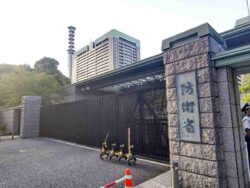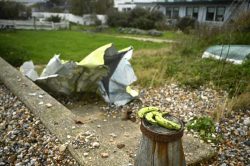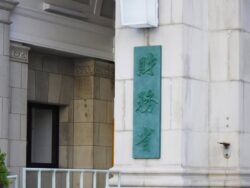
Tatsuhide Nojiri, who was the stationmaster of Kasumigaseki Station when the sarin gas attack was carried out on March 20, 1995, stands in front of a plaque to remember the victims, on Feb. 6 at Kasumigaseki Station in Tokyo.
17:54 JST, February 22, 2025
At around 8:10 a.m. during rush hour on Monday, March 20, 1995, commuters were thrown into a panic at Kasumigaseki Station, where the Hibiya, Marunouchi and Chiyoda lines of the Tokyo subway system pass through.
A short while earlier, senior members of the Aum Supreme Truth cult had released sarin, a highly poisonous nerve gas, on subway trains.
Tatsuhide Nojiri, now 73, who assumed the post of Kasumigaseki stationmaster on the day, was caught in a swirl of jumbled information. He had flipped posters over and taped them to lockers in the office so information could be written down as it was received via the station phone system.
There were reports saying, “Takahashi-san is lying on the platform,” and “He’s not breathing. I can’t feel a pulse.”
Kazumasa Takahashi, the then 50-year-old Kasumigaseki deputy stationmaster with whom Nojiri had only spoken to a short while before, was reportedly on the verge of death.
Nojiri wondered why on earth this was happening.
Nojiri had heard earlier that there had been an explosion at Tsukiji Station, but the details were not known at all.
As time went by, the information written on the back of the posters became increasingly serious with such notes as, “Another subway employee is unconscious,” and “A police officer also collapsed.”
There was a report that said the incident “might have been caused by a gas.” However, at this point, no one knew that the cause was sarin gas.
Everyone was just in a state of shock and confusion.
Masami Ohori, now 71, was a station employee at the time and could hardly believe it when he heard that Takahashi had collapsed.
Just two minutes earlier, he was having breakfast with Takahashi in the office after their night shift.
While Ohori cleared the table after breakfast, Takahashi said, “[I heard that] the floor of the front car of the train heading to Yoyogi-Uehara is wet, so I’ll go wipe it up.”
He then headed to the Chiyoda Line platform.
Ohori later rushed to the platform carrying a stretcher only to find Takahashi lying on the platform. He carried Takahashi to the office while another deputy stationmaster called for an ambulance.
“Kazumasa-san, hang in there. An ambulance is coming,” Ohori said.
He kept trying to talk to Takahashi, but there was no response. A passenger who was near him said that Takahashi yelled, “Ah!” then lost consciousness.
At the station office, Tsuneo Hishinuma, a then 51-year-old employee, who tried to clean up the substance with Takahashi, was also in pain. His cries of “I’m dying!” and “Help me! Help me!” echoed around the room.
Ohori, himself, later felt sick. After his colleagues helped him get to street level, he loosened his necktie and vomited.
It was chaos above ground, where the courthouse and central government buildings are located, and many people were in pain.
It took a while for an ambulance to reach him, but Ohori was eventually taken to a hospital with Takahashi.
At 11 a.m., the Metropolitan Police Department announced that the incident was “highly likely caused by sarin gas.”
According to Tokyo Metro Co., a company that operates a number of Tokyo subway lines, 238 of its staff members were either killed or injured in the attack. At Kasumigaseki Station, Takahashi and Hishinuma lost their lives.
Keishi Nagase, now 67, who was in the first car of the Chiyoda Line train that was exposed to sarin gas, saw Takahashi and Hishinuma cleaning up the liquid — later found to be sarin gas. He believes that he is alive thanks to the sacrifice of the two station employees.
The sarin gas attack was carried out by the cult led by Chizuo Matsumoto, better known as Shoko Asahara. In 2018, he was executed at the age of 63.
Thirteen were killed and over 6,000 were injured as a result of the attack. One woman suffered from the nerve gas’ effects for 25 years and died in 2020.
“I couldn’t do anything that day,” Nojiri said.
With a feeling of helplessness, he quietly waits for March 20 to pass.
"Society" POPULAR ARTICLE
-
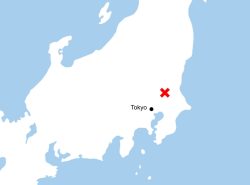
M4.9 Earthquake Hits Tokyo, Neighboring Prefectures
-
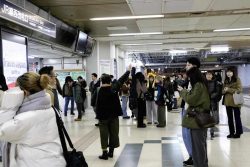
M7.5 Earthquake Hits Northern Japan; Tsunami Waves Observed in Hokkaido, Aomori and Iwate Prefectures
-

Tsukiji Market Urges Tourists to Avoid Visiting in Year-End
-

Israeli Tourists Refused Accommodation at Hotel in Japan’s Nagano Pref., Prompting Protest by Israeli Embassy and Probe by Prefecture
-
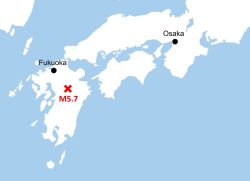
M5.7 Earthquake Hits Japan’s Kumamoto Pref., Measuring Upper 5 Intensity, No Tsunami Expected
JN ACCESS RANKING
-
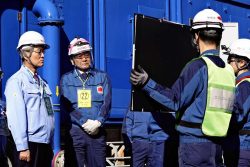
Keidanren Chairman Yoshinobu Tsutsui Visits Kashiwazaki-Kariwa Nuclear Power Plant; Inspects New Emergency Safety System
-

Imports of Rare Earths from China Facing Delays, May Be Caused by Deterioration of Japan-China Relations
-

University of Tokyo Professor Discusses Japanese Economic Security in Interview Ahead of Forum
-

Japan Pulls out of Vietnam Nuclear Project, Complicating Hanoi’s Power Plans
-

Govt Aims to Expand NISA Program Lineup, Abolish Age Restriction











